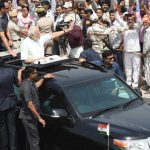As of today ( 27.05.2018) 07:00 am, Eastern Peripheral Expressway is operational for road users. Non-Delhi destined goods vehicles headed from Gurugram, Faridabad, Noida and Ghaziabad will be diverted onto EPE before entering Delhi. Additional police personnel are deployed at border entry points connecting Delhi with surrounding areas on EPE to help with smooth transitioning and diverting vehicles. Delhi Meerut Expressway phase I was inaugurated simultaneously.
The Delhi Meerut Expressway (Delhi Section) from Nizamuddin Bridge to UP border is developed by NHAI and Welspun Enterprises. Designed for commuters to go at a speed of up to 120 km/h, the roadway reduces travel time from 45-50 minutes to 8 minutes. Delhi-Meerut Expressway Phase I spans from Nizammudin Bridge to Delhi UP Border. The 14 lane, access controlled, roadway was constructed over 18 months at a cost of about Rs 841.50 crore. the 14 lanes are divided as follows – 6-lane Expressway and 4+4 Service lanes (two four-lane highways). Beautification and sustainable projects initiated along the way include a 2.5-metre-wide cycle track on either side, a vertical garden on Yamuna Bridge, solar lighting system and watering of plants through drip irrigation only.

B. K. Goenka – Chairman of Welspun Group said, “We congratulate the Honorable Prime Minister on completing 4 successful years at the Centre and sharing his vision to transform and connect India. We are thankful and proud to be associated with NHAI under the Hybrid Annuity Model. Welspun Enterprises was the first Company to achieve the financial closure for this expressway project. We are proud to contribute through industry first initiatives like vertical gardens, cycling track, solar lighting and beautification of this stretch. The completion of this expressway along with NHAI strongly showcases our strength in Infrastructure and truly resonates with our philosophy of ‘Leading Tomorrow Together’.”
Delhi Meerut Expressway project is planned for faster and safer road travel between Delhi and Meerut and in time more of Uttar Pradesh and Uttarakhand. Upon completion, travel time between Delhi to Meerut will be about an hour. The total length will be 82 kms of which the operational 27.74 kms is 14-laned. The remainder of Delhi Meerut Expressway will comprise of 6 lanes at an expected cost of Rs 4975.17 crore. There’ll be a 28 km stretch between Delhi and Dasna of cycles lanes. The project involves 11 flyovers/interchanges, 5 major and 24 minor bridges, 3 ROBs (rail over bridges), 36 vehicular and 14 pedestrian underpasses, and an elevated section of 5.91 kms.
Delhi Meerut Expressway phases (4) are as follows – Nizamuddin Bridge to UP Border (Km 0.000 to Km 8.360) – 14 lane
UP Border to Dasna (Km 8.360 to Km 27.740 = 19.28 kms – 14 lane
Dasna to Hapur (Km 27.740 to Km 49.346 = 22.27 km) – 6 lane
Green-field Alignment of Delhi-Meerut Expressway from Dasna to Meerut (27.740 to 59.983 = 31.78 km) – 6 lane Expressway

The 135 km long Eastern Peripheral Expressway (EPE) stretches from Kundli on NH 1 to Palwal on NH 2. Both Peripheral Expressways around Delhi – Western Peripheral Expressway (WPE) and Eastern Peripheral Expressway (EPE) will connect NH-1 and NH-2 to decongest traffic and thereby reduce pollution through diversion of traffic not headed to Delhi. EPE starts near Kundli NH-1, goes over Yamuna river, crosses SH-57 Mawikalan, NH-58 near Duhai, NH-24 near Dasna, NH-91 near Beel Akbarpur, Kasna-Sikandra road near Sirsa, river Yamuna again at village Faizupur Khadar (Haryana) , Atali-Chainsa Road (near village Maujpur) and ends at Palwal on NH-2 to join Western PE.
1700 hectares of land is acquired for EPE at a cost of about Rs. 5900 crore. Construction costs are at Rs 4617.87 crore. The fully access-controlled six-lane expressway has been built in 500 days. EPE closed tolling system collects toll for distance travelled rather than entire roadway length. Electronic Toll Collection (ETC) system aims for speedy toll collection. Weigh-in-Motion (WIMs) equipment are nstalled at all 30 entry points of the Expressway to keep away over-loaded vehicles. The 170 ft high toll plaza will house the ITS control system. 8 solar power plants with a capacity of 4000 KW (4 megawatt) have been be charged with lighting of underpasses and running solar pumps for watering plants. Rainwater harvesting points at every 500 meters and drip irrigation for plants aims at water preservation.






